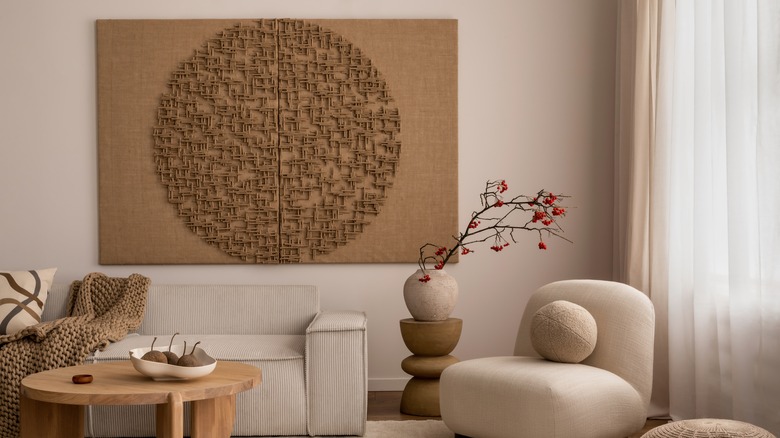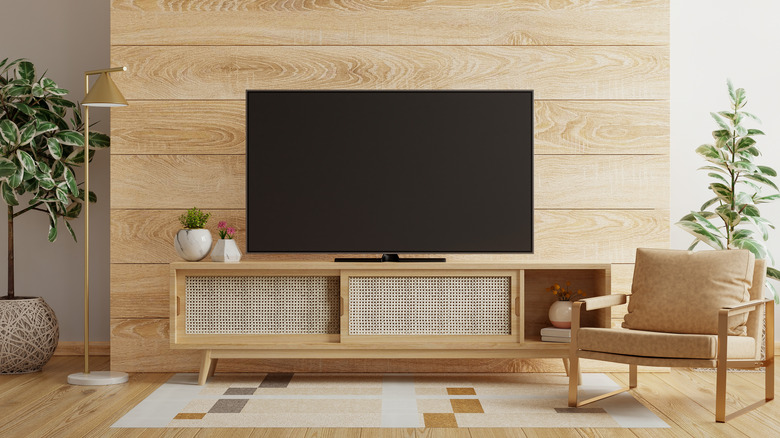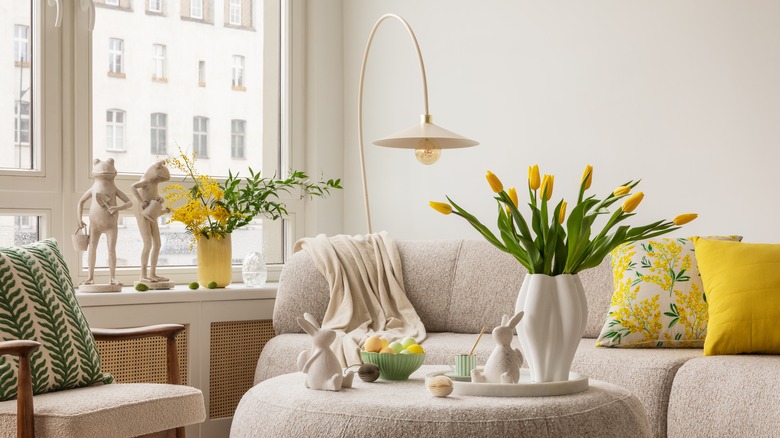Must-Know Design Tips For Creating A Cohesive Living Room Style
A living room that's designed with cohesion in mind instills a sense of tranquility, harmony, and even belonging. From wall finishes to the smallest accessory, every element seems to fit just as it should, and any chaos in your life ceases to exist the second you enter the room. The colors, textures, and styles work together magically to create an ecosystem — a habitat where you and your guests feel at home. To create a cohesive living room design, you must select the room's finishes and furnishings in a way that instills a sense of unity and peace in the space. Next, you must add touches of character through thoughtfully curated accents. You can achieve both of these design goals with these two tips. First, plan out the room's color palette, then use repetition judiciously while letting a few key accents stand out and tell your unique story.
Creating this idyllic living room aesthetic takes more planning and coordination than simply painting everything the same color. When you're trying to achieve cohesion, the point is not to create a rigidly uniform look — something like that would, frankly, belong more in an institutional setting than a home. Instead, the goal should be to create a space that feels like every single item was carefully chosen and pairs well with the rest of the elements in the room. Find out how to curate the ideal color palette and use repetition to create a uniform feel.
Curate a color palette to unify the room's finishes and furnishings
Creating a cohesive color palette in the room helps you anchor all the smaller design elements. You can start assembling your palette by landing on a base color, which will permeate the room's most prominent surfaces such as the walls, larger furnishings, and rugs. A neutral color works best in this capacity. It will allow you to later add an array of colorful accents to generate eclecticism without creating chaos. You can complement this base color by sprinkling other neutrals or similar tones of different intensities here and there. For example, cream-colored walls would pair well with an off-white sofa and a light-brown rug.
While the room's base helps build harmony in the space, without unique touches of personality, the harmonious look can appear sterile. So, once you've coordinated the shades of the majority of your walls and major furniture pieces, feel free to add accents that communicate your true essence visually. Choose a few colors and use them as a benchmark when selecting other wall finishes and decor elements in the room. As with the base, you can experiment with different shades and hues as you add accents to the room's design. To make a few of the elements really stand out, choose to decorate with items in complementary colors — such pairings are particularly vibrant.
Lean on repetition to cement the essence of harmony in the space
Some repetition can go a long way in creating cohesion, even with small accents. For example, if your living room is home to wooden furniture, the same color on the coffee table, bookshelf, and TV stand will help create a sense of harmony. You could amplify this effect by covering the baseboards, door casings, crown molding, and even the fireplace mantle in one color, too. Further, window coverings and accessories, such as throws and pillows, can also feature shades of one accent color. Between an omnipresent base color and some repetition among the furniture, trim, and accessories, your living room will exude a cozy, integrated ambiance.
Furthermore, your use of repetition in the room's design should not be limited to colors only. You can also repeat shapes, patterns, silhouettes, and sizes. The types of materials and textures you've chosen for window coverings, upholstery, rugs, and wooden pieces should communicate cohesion as well. For example, if your wooden coffee and accent tables are lacquered, a bookcase with a natural finish will stand out — and maybe not in a good way — even if its color is a match. That said, you don't need to match every single material, color, or pattern in the space. On the contrary, you can mix patterns in your home decor as long as they make sense within the overall color scheme.


